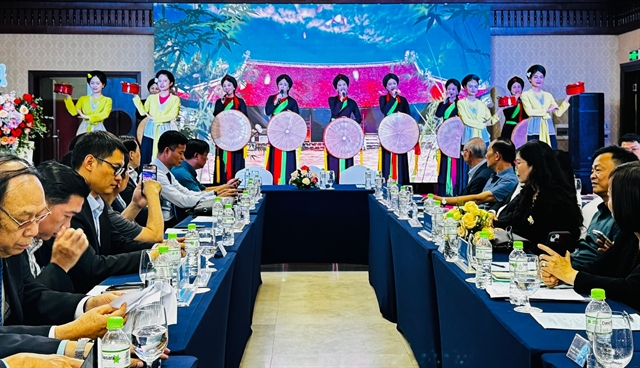With the advantage of being close to the capital Hà Nội, Bắc Giang's tourism has undergone changes in recent years, offering a variety of attractive products, notably cultural and spiritual tourism.

The Department of Culture, Sports and Tourism of Bắc Giang Province organised a tourism promotion event to introduce Bắc Giang as a travel destination in Hà Nội. Photo Hà Nội Mới (New Hà Nội) newspaper
HÀ NỘI — To promote regional tourism connectivity, especially routes linking with Hà Nội, the Department of Culture, Sports and Tourism of Bắc Giang Province is organising a destination promotion conference for Bắc Giang tourism at the Việt Nam International Travel Mart 2025.
With the advantage of being close to the capital Hà Nội, Bắc Giang's tourism has undergone changes in recent years, offering a variety of attractive products, notably cultural and spiritual tourism.
Bắc Giang is located in the northeast region of Việt Nam, bordering the capital Hà Nội and the provinces of Bắc Ninh, Hải Dương, Lạng Sơn, Quảng Ninh, and Thái Nguyên. It is also adjacent to the key economic triangle of Hà Nội – Hải Phòng – Quảng Ninh. This strategic location provides Bắc Giang with favourable conditions for economic and social exchange with neighbouring provinces and cities.
Belonging to the former Kinh Bắc region, Bắc Giang still preserves many unique traditional cultural and historical values, along with distinctive natural landscapes. These are essential resources that provide a strong foundation for tourism development. Currently, Bắc Giang's cultural heritage system spans all 10 districts, towns, and cities, with a total of 2,237 relic sites, including 759 sites recognised at various levels.
Bắc Giang also possesses five world heritages, including the intangible cultural heritages of Dân ca Quan họ (Quan họ folk singing), Ca trù, the practice of worshipping the Mother Goddess of the Vietnamese, the Then practice of the Tày – Nùng – Thái ethnic groups, and the Woodblocks of Vĩnh Nghiêm Pagoda – a Documentary Heritage of the Memory of the World Programme, Asia-Pacific Region.
Bắc Giang is blessed by nature with many beautiful landscapes that hold great potential for eco-tourism development.
Đỗ Tuấn Khoa, deputy director of the Department of Culture, Sports and Tourism of Bắc Giang province, said that Bắc Giang is currently developing four key types of tourism products: cultural and spiritual tourism; ecological and resort tourism; recreational, entertainment, and sports tourism (golf); and community-based tourism associated with fruit-growing regions, traditional craft villages, agricultural and rural tourism products, as well as UNESCO-recognised cultural heritages.
The province has also outlined a development plan for five tourism spaces, including Tây Yên Tử tourism space; tourism space associated with the Yên Thế Uprising; service, sports, and recreational tourism space; agricultural eco-tourism space; and quan họ cultural space.
“Based on this orientation, the province aims by 2030 to form several large-scale, provincial-level integrated tourism-service zones that can become national tourism areas. At the same time, we strive to build the Bắc Giang tourism brand into an attractive destination in the northern midland and mountainous region. The goal by 2025 is to welcome at least three million visitors and achieve total tourism revenue of VNĐ3 trillion,” Khoa said.
Contributing ideas for the development of Bắc Giang tourism, Phạm Văn Thuỷ, deputy director general of the Việt Nam National Authority of Tourism, emphasised that Bắc Giang is a locality rich in historical sites and beautiful landscapes, with great potential to develop tourism chains.
In the coming time, the province should pay more attention to tourism linkages with other localities, especially with the capital Hà Nội.
“The key issue is how to get visitors from Hà Nội to stay longer in Bắc Giang. To do so, the province needs a well-planned accommodation system and should develop a unique culinary identity. In terms of tourism products, Bắc Giang should build distinctive spiritual tourism routes and green tourism experiences that connect visitors with nature and local communities. Additionally, the province should focus on effective communication and promotional efforts,” Thuỷ noted. — VNS